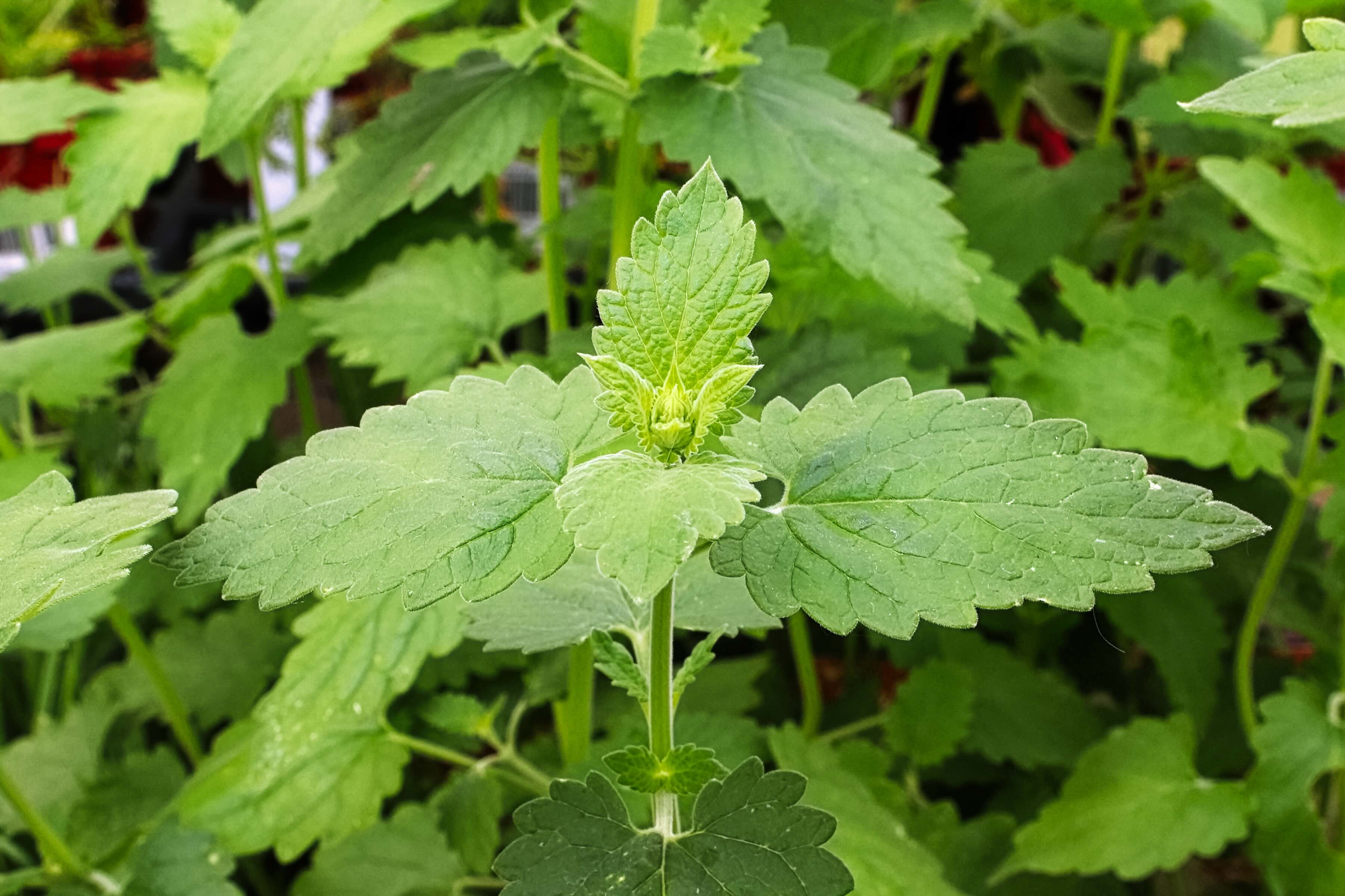Catnip. The very word can conjure images of cats in states of blissful abandon, rolling around, purring, and exhibiting behaviors that are both amusing and endearing to their human companions. But what exactly is catnip, and why does it have such a profound effect on so many of our feline friends? For those curious about enriching their cat’s life with natural and engaging play, understanding Catnip For Cats is key.
Key Facts About Catnip and Cats
- Catnip is a natural herb that elicits behavioral changes in approximately 60% of cats when they smell it.
- The effects of catnip are varied and can range from playful hyperactivity to mellow relaxation, depending on the individual cat.
- Catnip is generally safe for cats and can be a fun and enriching addition to their environment.
What is Catnip? A Closer Look at Nepeta Cataria
Catnip, scientifically known as Nepeta cataria, is a common herb belonging to the mint family, Lamiaceae. This resilient plant is native to parts of Europe and Asia but now thrives in North America and many other regions, easily cultivated in gardens. It’s characterized by its light-green foliage and delicate lavender flowers, adding a touch of beauty to any space it inhabits.
Beyond its appeal to cats, catnip has a history of human uses as well. Catnip leaves have been brewed into teas, and the flowers are traditionally believed to possess cough-relieving properties. Interestingly, catnip also finds its way into some natural insect repellent formulations, highlighting its versatile nature.
How Catnip Works Its Magic on Cats: The Science of Nepetalactone
The secret behind catnip’s enchanting effect on cats lies in an essential oil called nepetalactone, found within the plant’s leaves and stems. For a cat to experience the characteristic catnip reaction, they need to inhale this compound.
Cats possess a specialized olfactory organ called the vomeronasal gland, or Jacobson’s organ, located in the roof of their mouth. This organ acts as a supplementary scent receptor, enabling cats to detect and analyze pheromones and other complex scents. When a cat encounters catnip, the nepetalactone molecules are drawn into the nose and mouth, reaching this vomeronasal gland. This pathway directly transmits the scent signals to the brain, triggering the behavioral responses we associate with catnip. This unique sensory mechanism explains why smelling, rather than ingesting, catnip is what primarily induces the notable effects.
Why Are Cats So Attracted to Catnip? Mimicking Feline Chemistry
The allure of catnip for cats is rooted in nepetalactone’s ability to mimic feline sex pheromones. When a cat interacts with catnip, the nepetalactone triggers responses in the brain that are similar to the hormonal reactions experienced by a female cat in heat. Intriguingly, both male and female cats, and even neutered cats, can be susceptible to catnip’s effects.
The resulting behaviors are diverse and can manifest as overt displays of affection, such as rubbing, rolling, and purring, signaling relaxation and contentment. Cats under the influence of catnip may also exhibit signs of apparent happiness and playfulness. Conversely, some cats may become more energetic and engage in active behaviors like running, jumping, and heightened play, while in rare cases, catnip can even evoke temporary aggression in some felines. The specific reaction is highly individual, showcasing the fascinating diversity of feline responses to this herb.
Utilizing Catnip for Cats: Various Forms and Best Practices
 Close-up of fresh catnip (Nepeta cataria) leaves, a natural herb popular for cats due to its stimulating effects.
Close-up of fresh catnip (Nepeta cataria) leaves, a natural herb popular for cats due to its stimulating effects.
Catnip is readily available in a variety of forms to suit different preferences and purposes:
- Fresh Catnip: Growing your own catnip plant offers the freshest and most potent form of catnip. This allows for a continuous supply and the engaging experience of watching your cat interact directly with the living plant.
- Dried Catnip: Dried catnip is a convenient and widely available option. It can be sprinkled on toys, scratching posts, or bedding to entice your cat. Many commercially available cat toys come pre-filled with dried catnip.
- Catnip Sprays and Bubbles: Catnip sprays offer a mess-free way to apply catnip essence to toys or furniture. Catnip bubbles provide an interactive and playful experience, encouraging cats to chase and bat at the scented bubbles.
- Catnip-Infused Toys: Toys filled with dried catnip are a popular choice for providing long-lasting entertainment. These toys release catnip scent as the cat plays, prolonging the engagement.
Catnip sprays are particularly useful for cats with sensitive stomachs who might experience digestive upset from ingesting the plant directly. Spraying catnip on a cat’s favorite toy, cat tree, or scratcher can make these items more appealing and encourage their use. Similarly, dried catnip can be sprinkled on furniture or rubbed onto toys to enhance their attractiveness.
Veterinarians sometimes recommend catnip as a natural aid for managing mild separation anxiety in cats who are left alone. For cats who react positively to catnip, it can help reduce anxiety and potentially offer mild pain relief due to its relaxing properties.
Does Catnip Affect Every Cat? Individual Responses to Catnip
It’s important to note that not all cats are susceptible to catnip’s charms. Research indicates that approximately 60% of cats exhibit a behavioral response to catnip. This sensitivity is believed to be genetic, meaning a cat’s predisposition to react to catnip is largely inherited.
If your cat doesn’t respond to catnip, there are alternative plant-based options to explore. Silvervine and valerian root are two such plants that contain compounds similar to nepetalactone and can elicit comparable euphoric reactions in cats. These alternatives can be particularly appealing for cats who are immune to catnip’s effects, offering a different avenue for enrichment and play.
Duration of Catnip Effects and Tolerance
The effects of catnip are typically short-lived, generally lasting around 10 minutes per exposure. After this initial period, cats usually become temporarily immune to catnip’s effects for approximately 30 minutes. This refractory period is essential to prevent overstimulation and maintain catnip’s effectiveness for future use.
To preserve the potency of catnip, especially dried catnip, it’s best stored in an airtight container in a cool, dark place. This minimizes exposure to air and light, which can degrade nepetalactone over time, ensuring your catnip remains fresh and effective for longer.
Can Cats Overdose on Catnip? Safety Considerations
While catnip is considered non-addictive and generally safe for cats, excessive consumption can lead to mild, temporary gastrointestinal upset. Overindulging in catnip may cause symptoms like vomiting, diarrhea, dizziness, or temporary incoordination.
Moderation is Key: How Much Catnip is Appropriate?
A general guideline is to offer only a small amount of catnip at a time – about 1 tablespoon of dried catnip is usually sufficient. More than this amount is unlikely to intensify the pleasurable effects and might increase the risk of mild digestive issues. Fresh catnip is more potent than dried catnip, so even smaller quantities are recommended when using fresh leaves. Highly concentrated catnip oils should be used cautiously and sparingly due to their concentrated potency. If you have any concerns about the appropriate amount of catnip for your cat, consulting with your veterinarian is always a good idea.
Catnip FAQs: Addressing Common Questions
Does Catnip Make Cats High? Understanding the Effects
Catnip induces a state of altered behavior in cats that can resemble euphoria or intense happiness. Cats under the influence of catnip may display behaviors like rolling, playing, drooling, increased vocalization (meowing and yowling), hyperactivity, or, conversely, a temporary mellowing out.
While these behaviors might superficially resemble being “high” in humans, the physiological effects are different. Substances that truly induce a “high” in animals often involve symptoms like wobbly gait, disorientation, vomiting, and dilated pupils. These more severe symptoms are not typically associated with catnip exposure, indicating that catnip’s effects are milder and do not induce the same level of neurological impairment as substances that create a true “high”.
Can Kittens Use Catnip? Age and Catnip Sensitivity
Catnip is not harmful to kittens, but most kittens do not react to catnip until they are around 6 months to 1 year old. This is because the sensitivity to nepetalactone usually develops as kittens mature. While some younger kittens might exhibit a reaction, it’s less common before they reach sexual maturity.
Is it Safe for Cats to Eat Catnip? Ingestion and Digestion
Yes, cats can safely eat catnip, and in small amounts, it may even offer some digestive benefits. Catnip has historically been used in humans for its anti-diarrheal properties. However, it’s important to prevent cats from consuming large quantities of catnip, as this can lead to digestive upset, as mentioned earlier. Moderation is key even when ingesting catnip.
This exploration into catnip for cats reveals it to be a fascinating and generally safe way to enrich a feline’s life. From understanding its botanical origins and the science behind its effects to knowing how to use it responsibly, cat owners can confidently incorporate catnip into their cat’s playtime and environment, enhancing their well-being and enjoyment.

